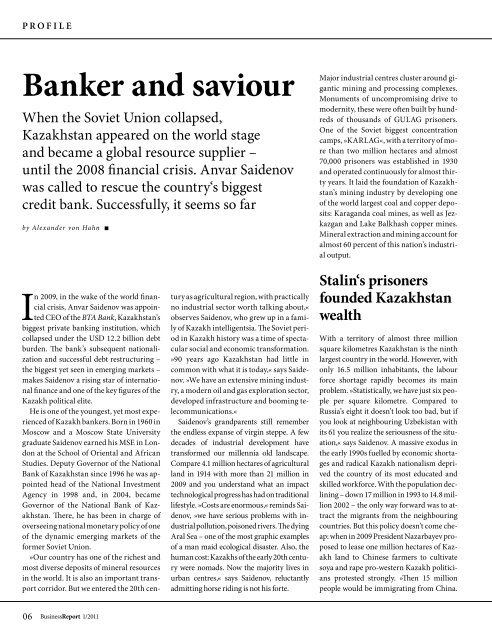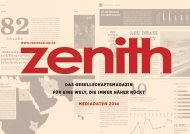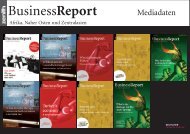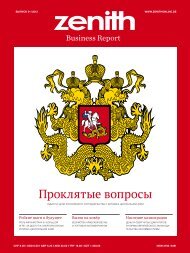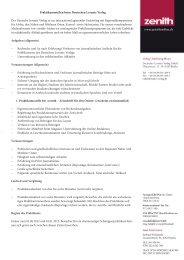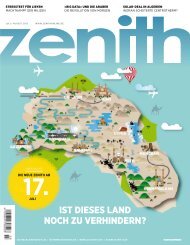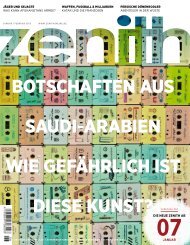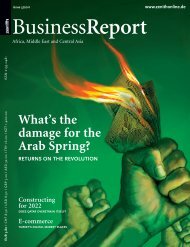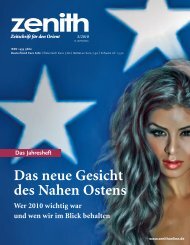Create successful ePaper yourself
Turn your PDF publications into a flip-book with our unique Google optimized e-Paper software.
PROFILE<br />
Banker and saviour<br />
When the Soviet Union collapsed,<br />
Kazakhstan appeared on the world stage<br />
and became a global resource supplier –<br />
until the 2008 financial crisis. Anvar Saidenov<br />
was called to rescue the country‘s biggest<br />
credit bank. Successfully, it seems so far<br />
by Alexander von Hahn<br />
In 2009, in the wake of the world financial<br />
crisis, Anvar Saidenov was appointed<br />
CEO of the BTA Bank, Kazakhstan’s<br />
biggest private banking institution, which<br />
collapsed under the USD 12.2 billion debt<br />
burden. The bank’s subsequent nationalization<br />
and successful debt restructuring –<br />
the biggest yet seen in emerging markets –<br />
makes Saidenov a rising star of international<br />
finance and one of the key figures of the<br />
Kazakh political elite.<br />
He is one of the youngest, yet most experienced<br />
of Kazakh bankers. Born in 1960 in<br />
Moscow and a Moscow State University<br />
graduate Saidenov earned his MSE in London<br />
at the School of Oriental and African<br />
Studies. Deputy Governor of the National<br />
Bank of Kazakhstan since 1996 he was appointed<br />
head of the National Investment<br />
Agency in 1998 and, in 2004, became<br />
Governor of the National Bank of Kazakhstan.<br />
There, he has been in charge of<br />
overseeing national monetary policy of one<br />
of the dynamic emerging markets of the<br />
former Soviet Union.<br />
»Our country has one of the richest and<br />
most diverse deposits of mineral resources<br />
in the world. It is also an important transport<br />
corridor. But we entered the 20th cen-<br />
06 BusinessReport 1/2011<br />
tury as agricultural region, with practically<br />
no industrial sector worth talking about,«<br />
observes Saidenov, who grew up in a family<br />
of Kazakh intelligentsia. The Soviet period<br />
in Kazakh history was a time of spectacular<br />
social and economic transformation.<br />
»90 years ago Kazakhstan had little in<br />
common with what it is today,« says Saidenov.<br />
»We have an extensive mining industry,<br />
a modern oil and gas exploration sector,<br />
developed infrastructure and booming telecommunications.«<br />
Saidenov’s grandparents still remember<br />
the endless expanse of virgin steppe. A few<br />
decades of industrial development have<br />
transformed our millennia old landscape.<br />
Compare 4.1 million hectares of agricultural<br />
land in 1914 with more than 21 million in<br />
2009 and you understand what an impact<br />
technological progress has had on traditional<br />
lifestyle. »Costs are enormous,« reminds Saidenov,<br />
»we have serious problems with industrial<br />
pollution, poisoned rivers. The dying<br />
Aral Sea – one of the most graphic examples<br />
of a man maid ecological disaster. Also, the<br />
human cost: Kazakhs of the early 20th century<br />
were nomads. Now the majority lives in<br />
urban centres,« says Saidenov, reluctantly<br />
admitting horse riding is not his forte.<br />
Major industrial centres cluster around gigantic<br />
mining and processing complexes.<br />
Monuments of uncompromising drive to<br />
modernity, these were often built by hundreds<br />
of thousands of GULAG prisoners.<br />
One of the Soviet biggest concentration<br />
camps, »KARLAG«, with a territory of more<br />
than two million hectares and almost<br />
70,000 prisoners was established in 1930<br />
and operated continuously for almost thirty<br />
years. It laid the foundation of Kazakhstan’s<br />
mining industry by developing one<br />
of the world largest coal and copper deposits:<br />
Karaganda coal mines, as well as Jezkazgan<br />
and Lake Balkhash copper mines.<br />
Mineral extraction and mining account for<br />
almost 60 percent of this nation’s industrial<br />
output.<br />
Stalin‘s prisoners<br />
founded Kazakhstan<br />
wealth<br />
With a territory of almost three million<br />
square kilometres Kazakhstan is the ninth<br />
largest country in the world. However, with<br />
only 16.5 million inhabitants, the labour<br />
force shortage rapidly becomes its main<br />
problem. »Statistically, we have just six people<br />
per square kilometre. Compared to<br />
Russia’s eight it doesn’t look too bad, but if<br />
you look at neighbouring Uzbekistan with<br />
its 61 you realize the seriousness of the situation,«<br />
says Saidenov. A massive exodus in<br />
the early 1990s fuelled by economic shortages<br />
and radical Kazakh nationalism deprived<br />
the country of its most educated and<br />
skilled workforce. With the population declining<br />
– down 17 million in 1993 to 14.8 million<br />
2002 – the only way forward was to attract<br />
the migrants from the neighbouring<br />
countries. But this policy doesn’t come cheap:<br />
when in 2009 President Nazarbayev proposed<br />
to lease one million hectares of Kazakh<br />
land to Chinese farmers to cultivate<br />
soya and rape pro-western Kazakh politicians<br />
protested strongly. »Then 15 million<br />
people would be immigrating from China.


